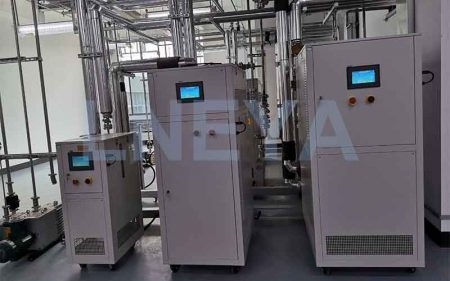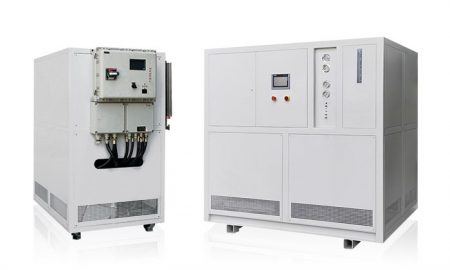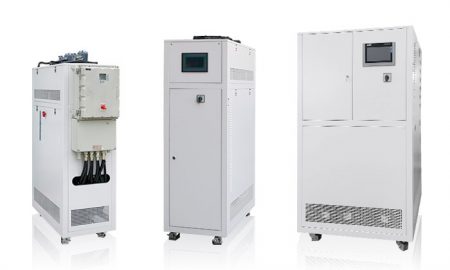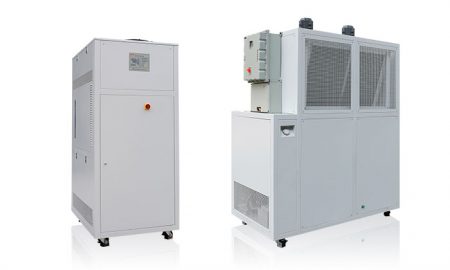Difference Between Glycol Chiller and Water Chiller
1. Why is glycol used for cooling?
Using a mixture of glycol and water as a coolant has many advantages over using water as a coolant. These advantages are attributed to its unique physical properties, including lower freezing point than water.
2. Heat transfer between water and glycol
For water without impurities, its freezing point is 32 ℉, which is much higher than when pure glycol becomes solid at 8.9 ℉. When the mixture of ethylene glycol and water is changed, the freezing point of the coolant will also change. For example, 10% ethylene glycol will freeze at 25.9 ℉ and 60% ethylene glycol solution will freeze at – 63 ℉.
From the above analysis, it is obvious that the refrigerant characteristics of ethylene glycol are more suitable for chillers operating in low temperature environment. Under these thermal conditions, the cooling water will freeze and hinder the circulation of the chiller, while reducing the overall efficiency.
In contrast, chillers using ethylene glycol will use its antifreeze characteristics to ensure that the coolant maintains the required fluid state.

3: Glycol chiller vs water chiller
Ethylene glycol chillers and chillers can be used to dissipate heat generated in the production process. The fundamental difference between the two types of chillers lies in the changes of their freezing point and heat conduction capacity.
The freezing point of pure ethylene glycol or a mixture of ethylene glycol and water is much lower than that of pure water. This means that glycol based chillers are more suitable for low temperature environments. On the contrary, compared with ethylene glycol mixture, water has better ability to retain and conduct heat in related processes. As a result, the heat transfer efficiency of the water chiller will be higher than that of the ethylene glycol chiller.
Generally speaking, users need to consider the ambient temperature of the site environment before selecting the type of chiller.
How does the glycol chiller system work?
Glycol chiller equipment consists of refrigeration components and pipes containing glycol and water mixture as coolant. The cooling fluid from the refrigeration unit is guided through a pipe associated with the heat exchanger surrounding the heating process. After absorbing heat from the relevant process, the warmed coolant is returned to the refrigeration unit for cooling, and then the process is repeated.
Ethylene glycol content in chilled water system
For many types of chillers, ethylene glycol is mixed with water in a ratio of 60 / 40. A higher percentage of ethylene glycol will greatly enhance the antifreeze performance of the mixture. This is useful when rapid cooling is required. In these cases, the process can be cooled to a very low temperature without freezing the coolant in the pipe.
How does the chiller system work?
Conventional water chillers work according to the principle of heat transfer between fluid and solid media. These cooling systems work by endothermic or vapor compression. The basic components of water chiller system include refrigeration unit and piping system of circulating cooling coolant.
Wir sind ein professioneller Hersteller von Kältemaschinen und Temperiergeräten und unterstützen kundenspezifische Dienstleistungen. uns konsultieren für Details!

Niedertemperatur-Kühlgeräte
Temperaturregelbereich: -150°C bis -5°C
Anwendung: Verschiedene Reaktoren, Destillations- oder Extraktionssysteme, Laboratorien, Forschungsinstitute, chemische, pharmazeutische, petrochemische, biochemische, medizinische Einrichtungen, Krankenhäuser, F&E-Werkstätten, Halbleitertests, Luft- und Raumfahrt, biologische und andere Industrien.
| Temperaturbereich | Serie -25°C ~ -5°C | Serie -45°C ~ -10°C | Serie -60°C ~ -10°C | Serie -80°C ~ -30°C | Serie -110°C ~ -50°C | Serie -150°C ~ -110°C |
| Kühlleistung | bis zu 360 kW | bis zu 360 kW | bis zu 360 kW | bis zu 270kW | bis zu 180kW | bis zu 11kW |

Rückkühler
Temperaturregelbereich: -120°C bis 30°C
Anwendung: Verschiedene Reaktoren, Destillations- oder Extraktionssysteme, Laboratorien, Forschungsinstitute, chemische, pharmazeutische, petrochemische, biochemische, medizinische Einrichtungen, Krankenhäuser, F&E-Werkstätten, Halbleitertests, Luft- und Raumfahrt, biologische und andere Industrien.
| Temperaturbereich | Serie -25°C ~ 30°C | -45°C ~ 30°C Serie | Serie -60°C ~ -20°C | Serie -80°C ~ -20°C | Serie -120°C ~ -70°C |
| Kühlleistung | bis zu 38kW | bis zu 12kW | bis zu 7,2 kW | bis zu 7,2 kW | bis zu 8,6 kW |

Normaltemperatur-Kühlgeräte
Temperaturregelbereich: +5°C bis +50°C
Anwendung: Verschiedene Reaktoren, Destillations- oder Extraktionssysteme, Laboratorien, Forschungsinstitute, chemische, pharmazeutische, petrochemische, biochemische, medizinische Einrichtungen, Krankenhäuser, F&E-Werkstätten, Halbleitertests, Luft- und Raumfahrt, biologische und andere Industrien.
| Temperaturbereich | -18°C ~ +30°C | +5°C ~ +50°C Reihe |
| Kühlleistung | bis zu 0,9 kW | bis zu 50kW |
 LNEYA
LNEYA
 简体中文
简体中文


















































































